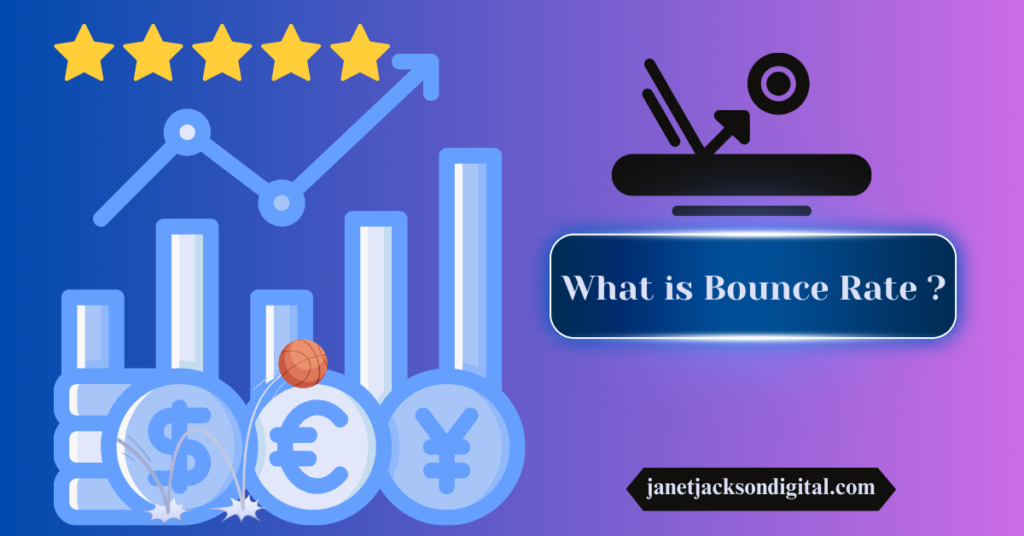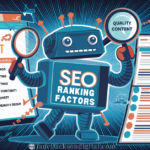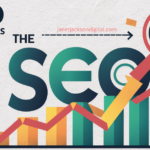Last Updated on July 3, 2024 by janetjacksondigital

Users who “bounce” are those that visited a page on your website (SEO) or a landing page but did not interact with it further. In the end, the site conversion rates suffered because they did not view additional pages or click on links. There are numerous ways to make your pages better so that visitors remain longer.
The word “bounce rate” may have come up in your research on best practices while starting an internet business.
This makes sense. It’s crucial to consider bounce rates. If you know what to look for, your website’s bounce rate can reveal a lot about your company and be a great tool for testing both new and old pages.
What is bounce rate?
The amount of visitors to your website that leave without clicking on any other pages save the one they initially landed on is known as your bounce rate. Stated differently, people “bounce” off your website practically right away.
Google defines bounce rate as follows, taken from its Analytics page:
“A session that results in only one request being made to the Analytics server, like when a user visits one page on your website and leaves without making any more requests to the Analytics server during that session, is specifically calculated as a bounce in Analytics.”
Exit rate vs bounce rate
Your exit rate and bounce rates are not the same thing. The percentage of users that leave your website after viewing a certain page is known as your exit rate, and a high exit rate isn’t always reason for concern.
For example, a high exit rate might be expected from a “thank you” page that appears after a consumer completes a transaction. A high bounce rate on that page would indicate that visitors were arriving there without going to any other pages on your website or making any purchases.
15 Simple Ways to Reduce Your Bounce Rate– Group Buy Seo Tools
Why is bounce rate important?
Your bounce rate is something you should be worried about. A high bounce rate is probably a sign of a dissatisfied user base and decreased revenue from visitors who leave your website without accomplishing anything. Optimizing your website’s conversion rate requires a thorough understanding of bounce rate.
Websites should be, to use marketing speak, “sticky,” meaning that new leads should want to stay on your site whether they find it through another source or on their own..
When determining who visits your page, Google takes into account your bounce rate. A visitor that takes the time to browse through several pages on your website is likely interested in and finding value in your material.
What is Bounce Rate? How to fix it?
How harmful is a high bounce rate?
The type of content you present will determine the response.
If you wish visitors to browse through all of the pages on your website, a high bounce rate indicates a problem. Perhaps a link in the navigation menu is broken, or visitors aren’t waiting around for your page to load quickly enough. Perhaps your site’s visitors aren’t interested in your material.
Conversely, a high bounce rate could be entirely reasonable if your website simply requires visitors to view one page. It makes sense for customers to click away from your website after completing an action, such as leaving a product review or sending you a message, if that is the main reason they visit it.
What, then, constitutes a favorable bounce rate? It varies. Depending on how each page is supposed to be used, individual pages will have varied bounce rates. For this reason, examining your site’s overall bounce rate might not be the most accurate representation of your situation. You might need to delve more to discover the truth.
How to calculate the bounce rate
It can be advisable to divide up your measures into different areas so you can see where and how visitors are interacting with your website.
For instance, calculating the bounce rate of your blog and landing page alone will get a more precise percentage than ranking them together. On a blog page, a high bounce rate wouldn’t be out of the ordinary. However, the purpose of your landing page is to direct visitors to other sections of your website, thus it should have a lower conversion rate.
One useful metric for A/B testing new page designs is the bounce rate of a single page. You’ll know which landing page design to choose with more confidently if you launch two versions and one of them has a noticeably greater bounce rate than the other.
What factors affect the rate at which you bounce back?
Decide the section of your website you want to examine before you start tracking your bounce rate. Is this the page that lands? pages of products? Subscribe to the newsletter? After you’ve identified the area that needs to be looked at, you may set a target % for your bounce rate and compare it to that number.
There are several elements that can impact your website’s or page’s bounce rate, such as:
- Your sector
- Whereabouts
- Which device users are using to access your website?
- Absence of CTA
- 404 Not Found
- inadequate user experience
- slow loading speeds
- False metadata
Determining the desired bounce rate
Using Google Analytics, you may calculate the typical bounce rate for your industry. To enable benchmarking, simply navigate to your account settings and select the relevant check box. Google will provide an estimate specific to your sector.
After determining the average, you can review your website to determine if it is performing on, above, or below par. Simply navigate to the Behavior section of Analytics, pick “Landing Pages” under the Site Content title, then drill down into the bounce rates for various portions of your website.
This is where your site-wide bounce rate appears. To obtain more information, you can click on each area or select the “Advanced Features” option located in the menu’s upper right corner. Furthermore, you can compare industry averages by vertical and time period to go even deeper.
You may determine which groups are visiting your site for the longest by segmenting your site data based on factors like age, gender, and geography. By examining the data in this manner, you can determine whether your website caters to a specific gender or age group, and you can modify your pages accordingly.
How to raise the rate at which pages load
There are no strict guidelines for lowering your bounce rate. On the other hand, by using a few common strategies on your own website and in your digital marketing initiatives, you can raise your bounce rate.
Address technical problems
Web development problems are usually technical in nature. If a software issue—such as a slow website with an abnormally long load time—is the primary cause of your high bounce rate, you can address it fairly quickly and simply with a technical fix. For example, you can hire a developer to optimize your website’s navigation and other areas, or you can buy more server space.
Make mobile-friendly adjustments
Since more people than ever browse the web on their phones, your website should be simple to use and navigate from mobile devices. On mobile devices, for instance, lengthy films can occasionally take a while to load. You may avoid the kind of slowness that causes users to leave a page by including shorter videos on your mobile version of the website.
Your website’s mobile version should be clear and simple, providing users with the information they require in a quick and easy manner.
Pay attention to user intent and entry points.
It’s critical to monitor the sources from which visitors arrive at your website.
Do they arrive via your newsletter via email? natural search? Social media advertisements that cost money? These components include things like your ad copy, meta description, and title tag.
People are likely to leave your page if your Facebook advertisement fails to prepare them for what they will see when they arrive.
Boost the user experience
To improve user experience, try your best to remove everything from your website that could irritate or distract visitors, including the ease of use of the navigation.
Someone will undoubtedly flee if they see a chatbot, a full-screen pop-up advertisement for your newsletter, and then a pop-up coupon offer all at once. When using popups and advertisements, consider their placement and make sure they blend in with your website rather than drawing attention to them.
Make sure to optimize on-page SEO and look at the keywords on your website and how they rank. Are you attracting the right individuals at the right times by employing the appropriate keywords for your industry?If you are offering marketing automation software, you want visitors to your website who are already familiar with it and can more easily comprehend the advantages that your product provides. You don’t want to draw in someone who is just now learning about the concept. That visitor may become overwhelmed and leave your site extremely fast if they find you and click through, which will lower the total bounce rate of your website.
To put it succinctly, ensure that the keywords that appear on your website correspond to its content. Try classifying the pages on your website according to subjects to see what categories they fall under, then make sure they’re drawing the appropriate
Observe your data
As with most other facets of digital marketing, you must monitor your data in this situation, which calls for putting policies in place that enable efficient data collection and analysis. You are unable to maximize your bounce rate if you do not possess access to all the required data.
Upon considering all of this data, trends will surface that can assist you in resolving the issue of excessive bounce rates in inappropriate locations. These trends will be easier to spot the more experienced you get at examining your measurements and interacting with the data.
lowering the bounce rate of your website
When assessing how well your website and its various pages are performing, you should keep an eye on the bounce rate. Although it’s common for some sites to have bounce rates that are higher than others, you still need to think about your marketing funnel.
If you observe that users are leaving sales pages quickly, you need to identify the issue. Resolving technical problems, making your website mobile-friendly, considering user experience, and reviewing your data can assist you in devising the most effective strategies for retaining clients. After customers convert, you can next begin creating methods for keeping them as clients.
With a variety of marketing tools at your disposal, such as landing page builders and website builders, Janet Jackson Digital can help you enhance your sales process. An analytics dashboard makes it simple to access your most important asset by storing all of the data collected from your Janet Jackson Seo Tools Provider site.
FAQs
What does bounce rate mean to you?
In web traffic analysis, the term “bounce rate” from Internet marketing is employed. It displays the proportion of users that arrive at the website, click away (“bounce”), and don’t browse any more pages on the same website.
A decent bounce rate is what?
A Good Bounce Rate: What Is It? What Makes a Bad One, Anyway? | Fullstory
A bounce rate of 40% or less is generally seen as good, while a bounce rate of 55% or more is regarded as excessive and may suggest that changes are necessary to interest visitors and entice them to explore more of your website.What in digital marketing terms is a bounce?
The bounce rate is the percentage of visitors to a website who land and only browse one or two pages before leaving.
Does SEO suffer from a high bounce rate?
It also hurts SEO. Actually, a high bounce rate and a brief dwell time could seriously harm your Google rankings. The phrase “best SEO tools” is a great example of this. The search results show that almost all of the results are lists of tools that users have used and recommended.
A bounce strategy: what is it?
Describe Buy a Bounce. The purchase a bounce trading method involves purchasing a securities once its price approaches a significant level of support. Those who “buy a bounce” try to take advantage of a brief market correction or “bounce” off the indicated support.

My name is Janet Jackson Seo and I work as a SEO Expert. I appreciate the process of developing an innovative approach and employing logic, particularly when it concerns future studies and SEO optimization. As an SEO expert I have known how to set up SEO campaigns fully and how to monitor their achievements.





